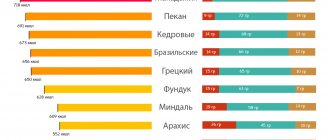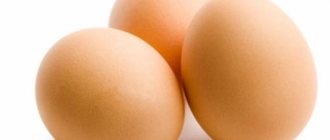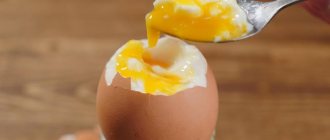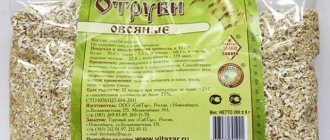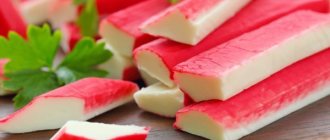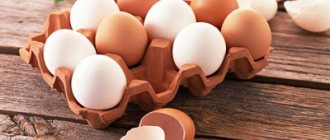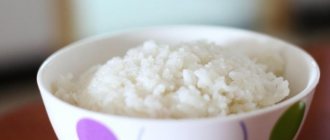Hard boiled eggs go great in salads and can be eaten on their own with salt and pepper.
Here's everything you need to know about hard-boiled eggs.
Hard boiled egg - calories, nutritional value and health benefits
Composition and nutritional value
Today, there is a lot of disagreement among both doctors and nutritionists regarding the addition of eggs to the diet. Some say that by consuming them you can eat without gaining weight, while others claim that this product is rich in bad cholesterol. Many questions arise about this. Let's try to find answers to them.
Even 15-20 years earlier, nutritionists argued that eggs were harmful due to their composition and the amount of cholesterol they contained. Today, this opinion has changed dramatically. This decision was influenced by a more thorough study of the product’s composition.
The approximate weight of one chicken egg is about 45 grams, and the protein contains:
- about 87% liquid;
- 11% protein;
- only one percent carbohydrates;
- minerals 1%.
The yolk is slightly different in its constituent indicators:
- half of the ingredients are water;
- fats in the amount of 30-31%;
- 17% protein;
- 2% minerals.
The composition is rich in such useful elements as calcium, phosphorus, iron, as well as potassium, sodium, zinc and selenium.
In addition, it contains many different vitamins of group B, A, D, E, K, Pp. Many nutritionists advise eating two boiled eggs every day in the morning, as they energize, invigorate and, of course, perfectly kill hunger. How many calories are in an egg depends on many factors. What affects this and how to reduce the number of calories?
Eggs for weight loss
Some diets use eggs for weight loss. First of all, we are talking about low-carb diets. Such diets are based on modern ideas about metabolism. By eliminating carbohydrates, we launch fat breakdown processes. As a result, ketone bodies appear in the blood, which help suppress appetite. Eggs can also be used in low-calorie diets. The calorie content of hard-boiled and soft-boiled eggs allows us to consider these products dietary. Their energy value per serving is low. And the feeling of fullness comes for a long time. Eggs are a source of valuable vitamins and microelements. Moreover, these substances are absorbed from eggs very well. A chicken egg per 100 grams contains: phosphorus - 192 milligrams, potassium - 140 milligrams, sodium - 134 milligrams, calcium - 55 milligrams, magnesium - 12 milligrams, iron - 2.5 milligrams, copper - 83 micrograms, cobalt - 10 micrograms. All these substances are especially needed to maintain health for those who are constantly struggling with excess weight through various unbalanced diets. However, overuse of eggs can lead to undesirable consequences. This is especially true for those whose cholesterol levels, according to blood biochemistry, exceed normal values. Therefore, eggs for weight loss should be used only with good blood biochemistry tests.
How many calories are in one egg?
People who carefully monitor the amount of calories they consume know that this amount is influenced by many factors. The energy value of an egg is directly affected by its weight and method of preparation.
The average energy value of one chicken egg reaches approximately 158 kcal. At the same time, the calorie content per 100 grams may vary, which is influenced by the cooking method. It is worth comparing the calorie content in each type of product and choosing the most suitable and safe option for your figure.
A raw egg
In its raw form, this natural product contains practically no carbohydrates. Thus, only the remaining components, that is, fats and proteins, affect the number of kilocalories. Fats are present in the yolk, and the second components are the basis of the protein.
The average energy value of this product in its raw form is approximately 70 kcal. If this product is subject to heat treatment, then the volume of kilocalories will change accordingly.
Boiled egg
According to gastroenterologists and nutritionists, a boiled egg is the most beneficial for both the figure and the health of the whole body. Experts advise eating this product boiled during breakfast. In this way, a feeling of dampness will come, and the body will be replenished with the necessary vitamins and elements.
One boiled egg contains a lot of boiled protein, which is responsible for the feeling of energy and vigor. The form of preparation is also important, that is, it will be soft-boiled or hard-boiled. Nutritionists give several recommendations that will help make this product not only tasty, but also healthy:
- Before cooking, rinse the shells with slightly warm water (this will help prevent serious diseases such as salmonellosis);
- cook in lightly salted water, while the amount of salt should be minimal;
- do not overcook the product, as this will negatively affect both its taste and beneficial qualities.
The average hard-boiled egg is approximately 55-60 kcal. Soft-boiled - approximately 70 kcal, as in raw form.
How many calories are in a boiled egg depends directly on the way it is prepared. It is better to use the product cooked soft-boiled.
Roast
Of course, this product when fried will be more nutritious than raw or boiled. In addition to increasing the amount of fat, this kind of dish can cause heartburn and other unpleasant symptoms, and is also contraindicated for people with acute pancreatitis, gastritis and other pathologies of the gastrointestinal tract.
The energy value is also affected by the frying method:
- without using oil - 100 kcal;
- with vegetable oil - 125 kcal.
Among people on a diet, a fairly popular dish is an omelette made from egg whites. There is a myth that the energy value of this dish is minimal. Is it really?
As already mentioned, the calorie content of a fried egg is affected by the frying method (with or without oil). An omelette made from proteins is prepared in vegetable oil, so its calorie content cannot be minimal. On average, 100 grams of such a product contains about 128 kcal, which is not the lowest figure.
Hard-boiled or fried egg: Which is better?
Hard-boiled eggs are made by placing unshelled eggs in a pan filled with cold water, then boiling them until the yolk is set. They are prepared without adding oil.
On the other hand, the process of cooking fried eggs requires the addition of vegetable oil, which adds additional calories and fat.
For example, one large hard-boiled egg contains 77 calories and 5.3 grams of fat, compared to 90 calories and 7 grams of fat in one large fried egg (1, 28).
Besides their fat and calorie content, boiled and fried eggs have very similar vitamin and mineral profiles. They do not differ in the amount of protein and nutrients.
Summary:
While hard-boiled eggs are cooked without additional ingredients, fried eggs require the addition of oil, which makes them higher in calories. However, fried and boiled eggs are very similar in composition.
Calories in white and yolk separately
The calorie content of white and yolk in an egg also differs. So, there is three times more of it in the yolk than in the white. On average, 100 grams of protein is 17 kcal. It contains a minimum of fat and a maximum amount of amino acids and B vitamins that are beneficial for humans.
The yolk contains 50 kcal, it also contains carbohydrates, fats, manganese, potassium, zinc and so on. Nutritionists recommend not consuming yolk together with other animal fats.
The calorie content of boiled and fried eggs is not the only issue that interests many losing weight girls and men. People also often wonder what is the benefit of this product?
Chemical composition
A chicken egg consists of white, yolk and shell. As a rule, a person takes only the first two ingredients in food. The protein part contains 9/10 water and 1/10 protein. As for the yolk, fat and cholesterol are concentrated in it. The protein content of the whole product is distributed as follows:
- protein - 56%;
- yolk - 33%;
- shell - 11%.
An egg contains 12 beneficial vitamins . In addition, it is deservedly considered the main supplier of retinol and vitamin D; it contains all representatives of group B and tocopherol. The product also contains choline, which is not found in such quantities anywhere else. The only thing missing from eggs is ascorbic acid.
Contains 95% minerals, including calcium, iodine, phosphorus, iron and others. The advantage is that nutrients are 97% absorbed by the body.
The chemical composition of a chicken egg is as follows (indicators are approximate, per 100 grams):
- The nutritional value:
- water - 76 g ;
- proteins - 13 g ;
- carbohydrates - 0.7 g ;
- dietary fiber - 2.5 g ;
- fats - 9.5 g ;
- ash - 1.1 g .
- Vitamins:
- retinol - 160 mcg ;
- choline – 320 mg ;
- thiamine - 0.05 mg ;
- riboflavin - 0.5 mg ;
- niacin - 0.08 mg ;
- pyridoxine - 0.17 mg ;
- pantothenic acid - 1.5 mg ;
- folic acid - 48 mg ;
- tocopherol - 1 mg ;
- cyanocobalamin - 0.9 mg ;
- phylloquinone - 0.3 mg ;
- calciferol - 2 mcg .
- Microelements:
- manganese - 29 mcg ;
- iron - 1.8 mg ;
- selenium - 31 mcg ;
- copper - 72 mcg ;
- fluoride - 1.1 mcg ;
- zinc - 1.3 mg .
- Macronutrients:
- phosphorus - 200 mg ;
- sodium - 143 mg ;
- magnesium - 13 mg ;
- potassium - 140 mg ;
- calcium - 57 mg .
Benefits of eggs
This product is used not only in dietary nutrition for weight loss, but also for medicinal purposes. It has an excellent effect on overall health and has excellent strengthening properties for the human body.
This natural product also has the following benefits:
- the substances contained in the composition perfectly protect the optic nerves and prevent the formation of cataracts;
- components that have a beneficial effect on the circulatory system, strengthen the vascular system;
- lecithin has strengthening properties for memory, affects the speed of thinking;
- stimulates the body's immune defense, preventing many diseases;
- has strengthening properties for bones and teeth;
- Vitamin E in the composition has a beneficial effect on the skin, hair, and helps maintain youth;
- Low-fat composition and relatively low calorie content help you lose weight.
Of course, there are many other foods with similar calorie content. However, it is chicken eggs that are most in demand due to their unusual taste, relatively low cost and the ability to prepare many different dishes based on them.
The greatest benefit will come only from fresh eggs. There are two ways to check this: a fresh egg does not make any sounds when shaken; a fresh egg placed in water immediately sinks; a not fresh egg rises to the top.
How to properly boil chicken eggs
Egg dishes come in a variety of cooking methods. In addition to the usual whole cooking, there are also more complex recipes, for example, “poached” - in boiling water without the shell.
But there are some useful tips on how to boil a chicken egg so that the yolk retains its color and benefits. Here is one of them:
- put the product in a pan and cover with cold water by five centimeters;
- put on fire and bring to a boil;
- remove from the stove and leave in water for 10 minutes;
- remove and cool.
To make cleaning easier, it is recommended to salt the cooking water well, and then keep the egg in cold water.
Eggs and diet food
Eggs are one of the natural foods included in the list of low-calorie foods. This product is often included in many diets and is often used for medicinal purposes.
Studies have shown that people who eat two boiled eggs every day in the morning, on average, reduce the calorie content of their diet per day by about 300 kilocalories.
Nutritionists recommend consuming this product at least 2-3 times a week; this will help not only lose weight, but also strengthen your body. There are certain diets for weight loss that include a distinct number of eggs per day. Eggs do an excellent job of normalizing metabolism in the body.
Summarize
- A hard-boiled egg is a low-calorie, nutrient-rich food.
- Eggs are an excellent source of high-quality protein and are rich in B vitamins, zinc, calcium and other important nutrients and antioxidants such as choline, lutein and zeaxanthin.
- Despite their high cholesterol levels, eggs do not appear to increase the risk of heart disease in most people.
- Boiled eggs are cooked without adding oil, so they contain fewer calories and fat than scrambled eggs.
- They can be one of the easiest and healthiest foods to add to your diet.
Eggs
Standards of use
If your cholesterol level is normal, you can eat one egg daily. With this dosage, the body will be replenished with the necessary beneficial components. If cholesterol levels are elevated, it is recommended to reduce the amount of product by eating 2-3 units per week.
If we talk about children, then the yolk is introduced into complementary foods around the seventh month of life. And at two or three years old, pediatricians advise children to eat 2-3 yolks for seven days.
Remember that eggs are usually found in many dishes. This is especially true for those who lose weight through diets, calculating the number of calories eaten per day. Thus, eggs are found in mayonnaise, baked goods, cutlets and other popular dishes.
Use of boiled eggs in cooking
Boiled eggs are included in most salads; no holiday feast is complete without them. They are used to decorate and season first courses, as well as filling pancakes and pies.
They can also be used as independent dishes, for example, for stuffing there are various filling options: meat and fish pates, herbs, cheese and vegetables.
Recommended reading: Benefits of goat cheese
Modern manufacturers offer special forms in which the product can be cooked without the shell. And here there is room to use your culinary imagination by adding finely chopped ham, green peas or sweet peppers. The dish turns out very beautiful and healthy for the figure.
We recommend reading: Benefits of bell pepper, properties
Chicken salad with egg pancakes
Ingredients:
- 500 grams of chicken fillet;
- 7 chicken eggs;
- onion;
- can of canned corn;
- 7 tbsp. l. sour cream;
- Art. l. rast. oils;
- 150 ml water;
- 1.5 tbsp. l. Sahara;
- salt.
Let's prepare our salad:
- We wash the fillet and set it to cook over medium heat. After the water boils, cook the meat for another half hour. Don't forget to salt the water.
- Peel the onion and cut into half rings.
- Prepare the pancakes: break the eggs into a bowl and add a little salt. Shake with a fork. Fry the pancakes in a frying pan in vegetable oil on both sides for a minute.
- We should have about seven pancakes. Stack them and cut them into thin strips.
- We cut the boiled chicken fillet into strips.
- Fry the onion for 3-4 minutes.
- Now we assemble the salad: put the fillet, onion, pancakes and corn together and mix. Season with sour cream. If the salad seems unsalted, add a little salt.
The salad will taste better if it is left to cool in the refrigerator for an hour. Bon appetit!
Types of eggs and their calorie content
The popularity of the product is explained by its high taste characteristics and benefits for the body. In modern cooking, there are dozens of options for their preparation - from modest fried eggs to masterpieces of confectionery art.
Photo: adayinthekitchen.com
Eggs are easy to digest, and their chemical composition is rich in valuable elements and vitamins. This is one of the few components of the diet that is absorbed in almost 100% volume.
Several types of eggs are in demand among consumers:
- Chicken is a classic of the genre and a hit in the budget consumer basket. The nutritional value of 1 chicken egg in nutrition is equal to 100 g of meat. They are found with white and brown shells. The color of the shell matches the chicken's plumage. The average weight of 1 piece is 70 g.
- Quail eggs occupy 2nd place in terms of prevalence. They are fattier than chicken, but less allergenic. They are considered an environmentally friendly product, since poultry requires careful treatment and a thoughtful menu of harmless “chemicals”. The small egg is protected by a speckled shell and weighs about 17 g.
- Goose egg is a product with an expressive taste and powerful antioxidant properties. It is useful for strengthening the immune system and is actively used in cooking. Sold only at farmers' markets. The average weight of 1 copy is 200 g.
- Turkey eggs are similar in appearance and nutritional value to their chicken counterparts. The main difference is the higher fat content. Turkeys lay few eggs and seasonally, so their eggs are purchased individually by contacting the farmer-breeder. Weight of 1 piece – 70-72 g.
- Ostrich eggs are large exotic specimens. Giant size and bright taste are their key features. The weight of eggs depends on the breed of ostrich. A common indicator is 1600 g.
One ostrich egg can feed a company of 10 people.
Photo: quora.com
- Egg powder, or melange (from the French mélange - mixture) - dried and crushed whites and yolks of ordinary eggs. It is used for preparing dishes - omelettes, pastries, cutlets. The advantages of dry mixture over fresh eggs are a long shelf life and the absence of pathogenic microbes. During the processing process, whites and yolks are pasteurized.
Let’s figure out which egg is better, quail or chicken, together with Elena Malysheva in the program “Live Healthy.”
The energy value of eggs varies. The large size of the bird does not guarantee a high calorie content of the product. This is noticeable when comparing the calorie content per 100 grams and per 1 raw egg :
| View | Kcal per 100 g. | Kcal in 1 piece |
| Chicken | 157 | 100 |
| Quail | 168 | 28,5 |
| Gusinoye | 100 | 200 |
| Indyushinoye | 170 | 123 |
| Ostrich | 120 | 1300 |
| Egg powder | 540 | — |
The number of calories consumed will depend on the amount of egg mass eaten. We invite you to familiarize yourself with the egg diet, which is good for your figure, health, and is suitable for people with diabetes.
Making Egg White Easy
How much protein is in the egg white, its benefits and is it possible to eat the yolk?
Eggs are one of the few foods that can be eaten in any form of preparation. Moreover, each of these forms is accessible even to a convinced bachelor who is far from culinary delights.
And although the protein content is always constant and equal to approximately 6-7 grams, its usefulness greatly depends on the preparation of the final product.
From top to bottom, most valuable to least useful:
- raw eggs;
- soft-boiled;
- in a bag;
- hard-boiled;
- fried eggs.
In other words, the more active the heat treatment, the less benefit the consumption brings to the body. The reason is simple - the amino acid profile is destroyed under high temperatures.
Despite this, it is not recommended to eat chicken eggs raw. They can be the source of diseases such as salmonellosis. Minimal heat treatment (soft-boiled) will protect you from diseases without significantly harming the quality of the product.
Structure and features
This product has great biological value due to the content of chicken eggs that improve the functioning of the body and strengthen the immune system. Consumption of 1-2 pieces per day to cover the body's need for useful elements. The yellowness of the yolk is explained by the presence of carotene, xanthophyll and carotenoid in the composition. It is also worth noting that there are differences between the eggs of chickens and waterfowl. have 15% and 14% more fat and protein .
Let's look at each of the elements:
- Protein - a substance that is formed from 4 layers having different densities:
- outer layer - 23%;
dense protein - 58%;
- internal liquid protein - 17%;
- hailstone protein (adjacent directly to the yellow membrane) - 2%.
- carbohydrates - 0,8%;
- water - 85%;
- fats - 0,3%;
- proteins - 11%.
- glucose;
- amino acids;
- vitamins and enzymes.
- ovalbumin (more than half);
- ovoglobulins;
- lysozymes;
- ovomucoids;
- ovomucines;
- ovotransferrins.
- Yolk - an equally important element, which is an opaque and thick mass located inside a special shell. The task of the latter is to protect the yolk and give it a certain shape. The overall density is at the level of 1.028-1.029. The color can vary from light yellow to dark orange. The yolk consists of the following layers:
- light yolk;
yellow yolk;
- yolk central part (core);
- embryo
- cholesterol - 140 mg ;
- proteins - 2,7%;
- carbohydrates - 0,6%;
- fats - 4,5%.
- retinol;
- vitamins D and B;
- tocopherol;
- lecithin;
- choline;
- polyunsaturated fatty acids (linoleic and linolenic acids - 6% and 16% , respectively);
- monosaturated fatty acids (oleic and palmitoleic acids - 47% and 5% , respectively);
- saturated fatty acids - palmitic ( 23% ), myristic ( 1% ) and stearic ( 4% ).
- Shell. Many people underestimate the importance of another element of a chicken egg - the outer hard shell. It contains the following elements:
- calcium phosphate;
magnesium;
- copper;
- iron;
- collagen.
- white - in egg-bearing breeds;
- yellowish or brown - for meat.
- Wash the shell in soapy water after removing it from the raw egg.
- Let the product dry, then peel off the film from the inside and grind the shells using a coffee grinder.
The yolk is held in the central part using special ligaments (hailstones). The quality of the product is often judged by the volume of the dense part. In the case of long-term storage, the structure of the substance liquefies, and the chemical composition of the eggs gradually changes.
Protein is a building material that is used by the body to build new tissues. With its help, muscles are formed, the immune system is strengthened, and metabolic processes are improved.
Compound:
The protein also contains:
Calorie content - 17-20 kcal .
The chemical composition of protein deserves special attention:
Changes in the composition and calorie content of the yolk directly depend on the protein mixture around it. If the protein liquefies, then the water that is bound to it comes out and penetrates through the shell, and then through the outer protection of the yolk. As a result, the size of the latter increases, and the yolk itself becomes ellipsoidal.
Nutritionists claim that the central part is the main one. This is explained by its high calorie content - 50-60 kcal .
Chicken yolk composition:
Many people are concerned about high cholesterol levels. In fact, the existing harm is compensated by the action of lecithin. In addition, the product contains a large amount of healthy fats, without which the body is not able to develop normally.
Let's look at what is contained in the yolk:
The thickness of the shell varies depending on the breed of bird. On average, this figure ranges from 0.3 to 0.6 mm . The shell contains more than 7.5 thousand pores. At the same time, there are fewer of them on the “blunt” side, which explains its lower rigidity. Pores in the shell allow moisture and carbon dioxide to escape from the egg. In addition, it protects against the effects of negative natural factors.
The shell varies in color:
The quality of the shell and egg as a whole can be recognized by the following criteria - smoothness, cleanliness and density.
On the surface of the shell there is an additional (suprashell) shell. It is thanks to this protection that the evaporation of moisture, which is contained in the yolk of a chicken egg, as well as in the white of the product, is prevented.
The egg also has an undershell shell that protects the inside from the penetration of bacteria, UV rays and water vapor. This defense is often referred to in the literature as protein defense.
If a chicken egg has just been laid, then there is still no air space between several shells. After cooling, the volume of the egg decreases, and the protein part inside pulls the shell layer towards itself. The outer shell remains in place, creating space between the two shells. The longer the product is stored, the greater this distance becomes. By the size of the space you can judge how fresh the product is.
Eggshells are one of the best sources of calcium. Already one egg contains 1.8-2.0 grams of a useful element. Other substances are also present in the composition - iron, phosphorus, copper and manganese.
People often throw away the shells. In practice, its technique is very useful. The calcium in the shell is almost completely absorbed by the body, improving the condition of nails, teeth and fingernails. To “cook” follow these steps:
Please note that it is prohibited to take shells without a doctor’s recommendation due to the presence of some contraindications (for example, if you have cancer).
How to select and store
The characteristics are subject to the requirements of state standards. The shells of eggs that go on sale must be marked with letters and numbers. What does it mean?
- The letter designations “D” or “C” indicate the “age” of the product. “D” (dietary) - those that ended up on the counter within the first 7 days from the date of production. Such products can be purchased in the immediate vicinity of the production site. “C” (table eggs) are sold everywhere.
The degree of freshness is the main difference between products of categories “D” and “C”. Dietary eggs “older” than 7 days mechanically pass into the category of table eggs.
Photo: gulfnews.com
- Digital marking indicates mass. The higher the number, the lighter and smaller the egg. Selected product C0 (weight from 65 to 74.9 g) is heavier and larger than C1 (category 1 weighing 55-64.9 g). Large specimens weighing more than 75 g are marked with the letter “B” and belong to the highest category.
The taste and quality of eggs do not depend on their size and shell color.
In the store you should pay attention to 2 points:
- Date of manufacture. Eggs remain fresh for 25 days when stored at room temperature and 120 days when stored in the refrigerator.
- Manufacturer's address. The closer the manufacturing site is to the sales center, the better.
At home, eggs should be stored away from substances with strong odors. The optimal temperature is from 0 to 5°C.
You will learn about the freshness of eggs and beneficial properties from this talk show “About the Most Important Thing” with Sergei Agapkin and Doctor of Medical Sciences, leading researcher, professor of the Federal State Budgetary Institution of Science “Federal Research Center for Nutrition and Biotechnology”, doctor of the highest category, Alla Vladimirovna Pogozheva.
